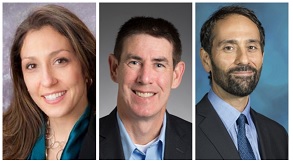
McGowan Institute for Regenerative Medicine faculty member Fabrisia Ambrosio, PhD, MPT, Director of Rehabilitation for UPMC International and Associate Professor in the Department of Physical Medicine & Rehabilitation at the University of Pittsburgh with secondary appointments in the Departments of Physical Therapy, Bioengineering, Orthopaedic Surgery, and Microbiology & Molecular Genetics, and Carnegie Mellon University’s Philip LeDuc, PhD, William J. Brown Professor of Mechanical Engineering with appointments in Biological Sciences, Computational Biology, and Biomedical Engineering, the Founding Director of the Center for the Mechanics and Engineering of Cellular Systems, and a McGowan Institute affiliated faculty member, are the co-principal investigators on a recently awarded National Institutes of Health R01 grant entitled “Role of Extracellular Matrix in Age-Related Declines of Muscle Regeneration.”
Co-investigators of this work include McGowan Institute affiliated faculty member Antonio D’Amore, PhD, Research Assistant Professor in the Departments of Surgery and Bioengineering, and Pitt’s Aaron Barchowsky, PhD, and Claudette St. Croix, PhD.
The project abstract reads:
Skeletal muscle trauma resulting from an injury or surgery often results in significant functional declines in older adults. These declines are at least partially attributed to failed muscle healing. Muscle regeneration is predominantly dictated by the action of muscle stem, or “satellite”, cells (MuSCs), a reserve cell population that typically demonstrates considerable dysfunction with increasing age. According to the stem cell “niche” concept, stem cell responses are largely determined by biophysical and biochemical cues that emanate from the surrounding microenvironment. Indeed, expanding recognition of the influence of the microenvironment on stem cell behavior has led to a recent surge in the development of bioinspired and engineered extracellular matrix (ECM) approaches for the treatment of skeletal muscle injuries. Still lacking, however, is an in-depth knowledge of whether and how pathogenic instructional characteristics of the native ECM disrupt MuSC function and skeletal muscle regeneration. While it is evident that MuSC activation, self-renewal, proliferation and differentiation are influenced by physical and dynamic niche interactions, a mechanistic understanding of the direct impact of age-related ECM alterations on skeletal muscle regenerative capacity is unknown.
The over-arching goal of this project is to test the central hypothesis that age-related biophysical alterations in the skeletal muscle ECM promotes a fibrogenic conversion in MuSCs, ultimately driving impaired skeletal muscle regeneration. Further, the team hypothesizes that these pathogenic biophysical changes may be reverted, at least partially, by mechanical stimulation. To achieve this goal, they will employ an integrated approach that encompasses cutting-edge super-resolution imaging and 3-D tissue engineering methods to address two specific aims.
Aim 1 studies will measure, manipulate, and mimic the biophysical properties of young and aged skeletal muscle ECM in order to dissect the effect of age-related architectural and elastic ECM modifications on MuSC fate. Aim 2 studies will identify mechanisms by which mechanical stimulation modulates biophysical properties of the aged ECM to promote MuSC myogenicity and muscle regeneration. Successful achievement of these aims will further our understanding of 1) the instructional capabilities of the native ECM on MuSC lineage specification, 2) how these instructional capabilities change over time, and 3) the molecular mechanisms controlling age-related declines in skeletal muscle regenerative potential. Taken together, successful completion of these studies may provide a foundation for the identification of novel ECM targets in the treatment of skeletal muscle injuries for a geriatric population. More broadly, an improved insight into how age-associated alterations in biomechanical, architectural and dynamic ECM properties direct MuSC function will expand the fundamental understanding of aging and stem cell biology.
Congratulations, all!
